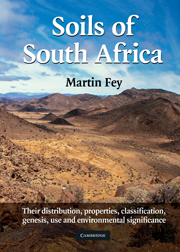Book contents
- Frontmatter
- Contents
- Preface and acknowledgements
- Chapter 1 Introduction to the soil groups and the naming of forms and families
- Chapter 2 The soil groups: distribution, properties, classification, genesis and use
- Chapter 3 Animals in soil environments
- Chapter 4 Profile descriptions and analytical data
- References
- Glossary
- Appendix: Criteria for generating distribution maps for soil groups
- Index
Chapter 4 - Profile descriptions and analytical data
Published online by Cambridge University Press: 05 June 2012
- Frontmatter
- Contents
- Preface and acknowledgements
- Chapter 1 Introduction to the soil groups and the naming of forms and families
- Chapter 2 The soil groups: distribution, properties, classification, genesis and use
- Chapter 3 Animals in soil environments
- Chapter 4 Profile descriptions and analytical data
- References
- Glossary
- Appendix: Criteria for generating distribution maps for soil groups
- Index
Summary
INTRODUCTION
Soil description
First dig a pit and savour the geosmin.
Mark next the slope and aspect, vale or hill.
Horizons in the profile take some skill,
Surface features first; know vegetation.
View pit face with love, imagination.
Feel, observe, describe each special feature.
Systematic'ly move your adventure,
Up and down, admitting information:
Moisture; Munsell hue; texture in the main;
Consistence, this must relate to moisture;
Structure: grade, shape (beauty in creation);
Not forgetting roots; pores and nodules, plain
Or complex; path of burrowing creature;
Last, inspect horizons for transition.
During the 1970s South Africa had the good fortune to have a government department, then known as Agricultural Technical Services, which included a number of specialised institutes one of which was the Soil and Irrigation Research Institute. There was nothing particularly special about this institute (it had its normal share of dead wood and bureaucracy) besides the fact that among its employees were some soil scientists who, with great vision and enthusiasm, initiated what was to become known as the Land Type Survey of South Africa. This was an ambitious project which continued over nearly three decades – classifying, mapping, describing, sampling and analysing soils in relation to natural mapping units termed land types. Each land type consists of a defined combination of soil types, terrain pattern and climate. Land types have been mapped at a scale of 1:250 000 and accompanying memoirs (mostly published) provide quantitative information on the soils of each land type as well as descriptions and analytical data for modal soil profiles that were selected to represent the most abundant soils within each land type.
- Type
- Chapter
- Information
- Soils of South Africa , pp. 176 - 259Publisher: Cambridge University PressPrint publication year: 2010

